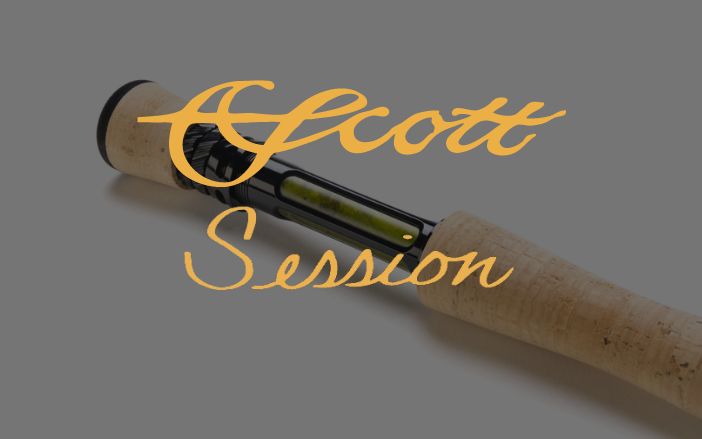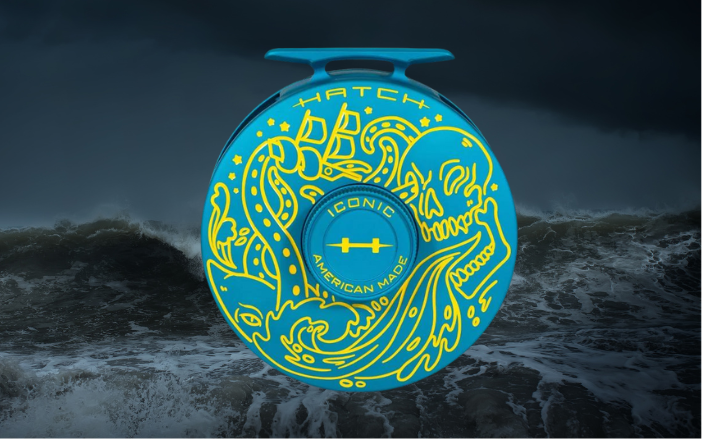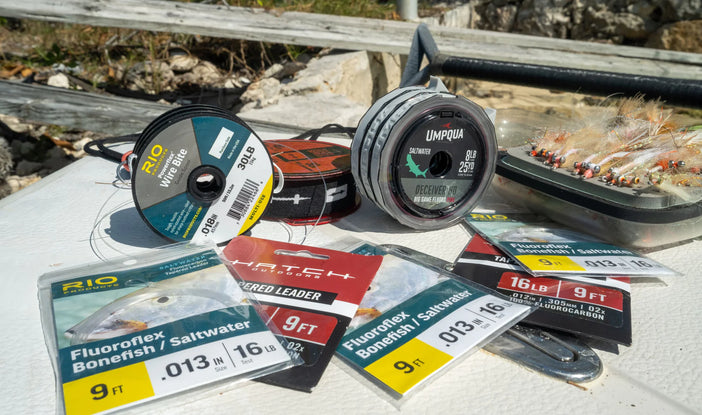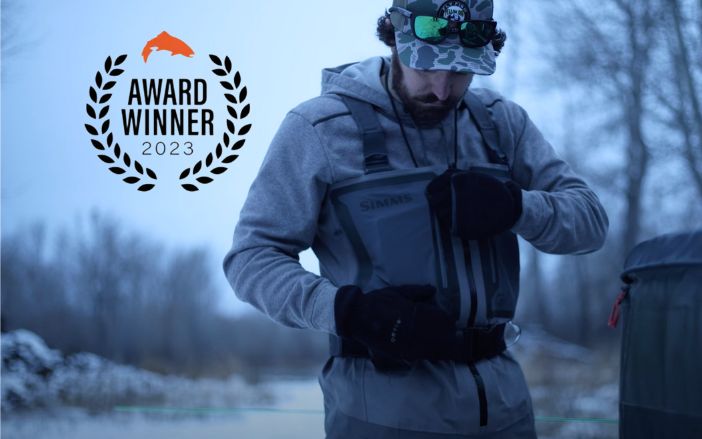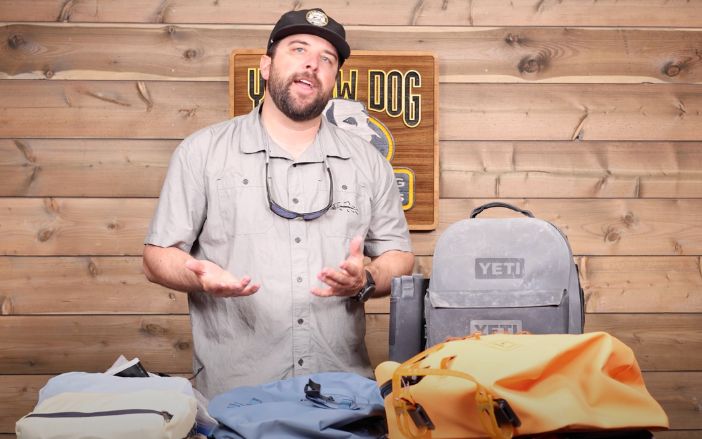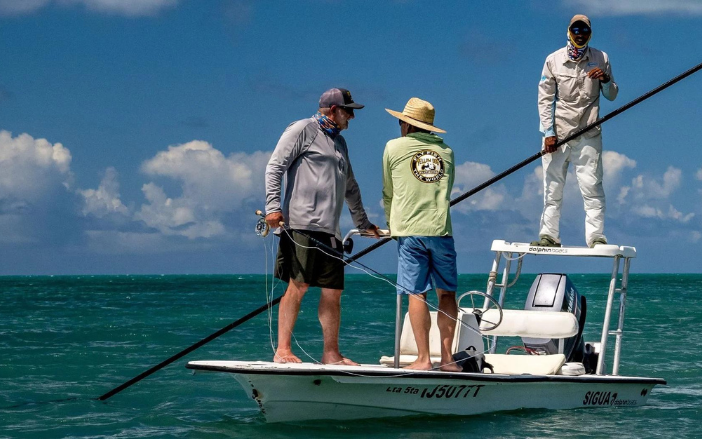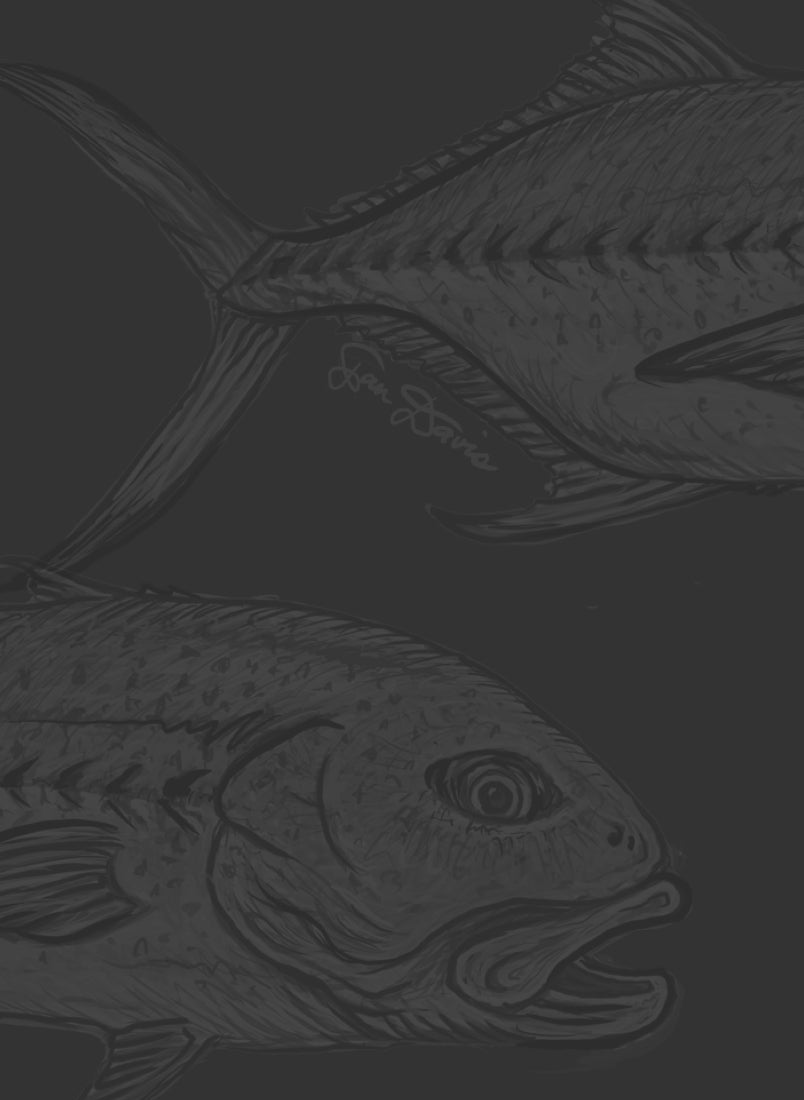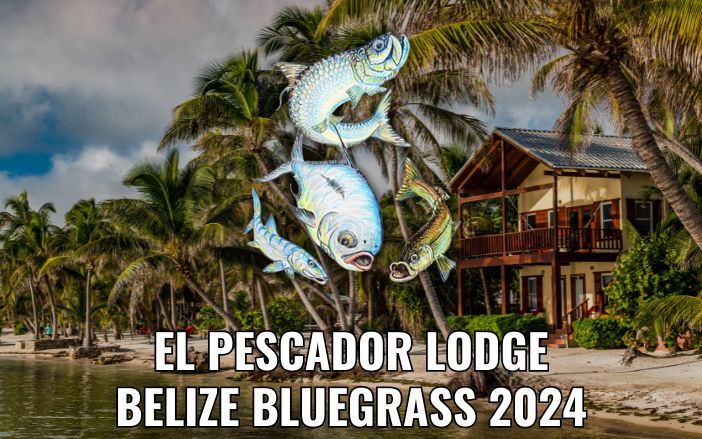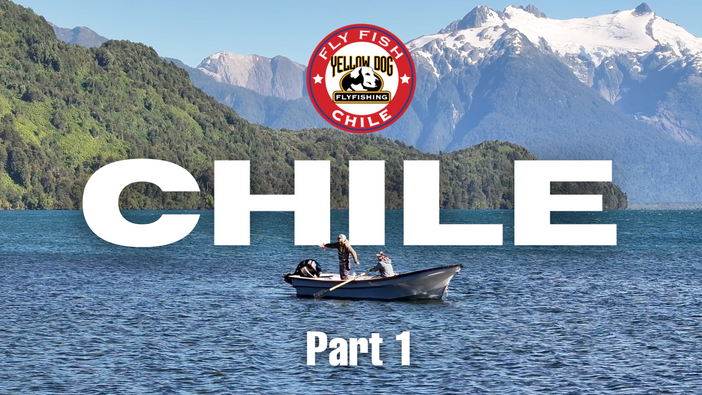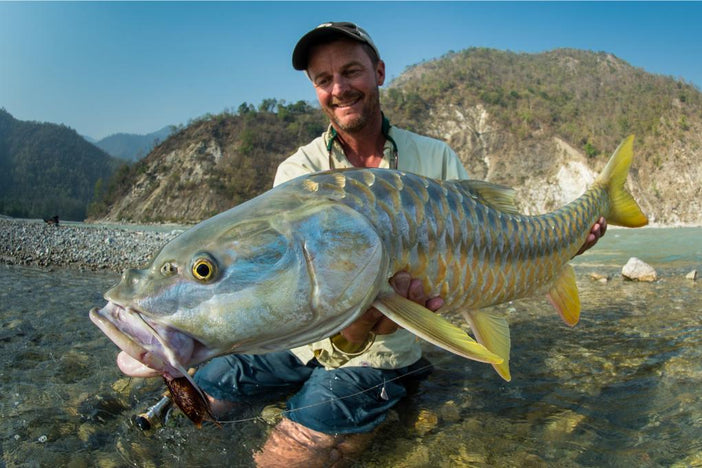Late October and November bring cold mornings and the very real possibility of snow to the Rocky Mountain West. But, that doesn’t mean it is time, just yet, to hang up the fly rods. In fact, if you have the desire to get in one more western trout fly fishing trip this season, there is still time.
Clothes that have been stowed away since last bird season are being unpacked and dogs are starting to excite with the not too far-off retrieves. Fall also means fly fishing during, arguably, the best time of the year. As summer crowds return to careers and lives off the water, rivers are offered a bit of respite from the high-season traffic.
And for anglers, the possibility of world-class rivers to themselves is enough to get anyone out of bed on a cold autumn morning. If you’re like us and enjoy brisk fall days on the river then you definitely want to check out the following destinations for your fall fly fishing adventure. Please note that this list is not exhaustive and of course there are some rivers missing. We’ll leave those up to you to discover!
Montana
We’re a little biased here. After all, we’re located in Bozeman, Montana and have access to all of the state’s great rivers. And after a crazy summer season in a place that derives a large portion of its business from tourism, fall is a time Montanans get to take a deep breath and relax a bit after the chaos. Come fall anglers can thoroughly enjoy the treasures of Montana’s rivers. It’s the time when rainbows and browns start to spawn and finding a territorial agitated trout is not uncommon. Although we love stripping streamers in hopes of our next big brown, we strongly believe that anglers should adhere to the strictest of ethics. If it’s in question whether or not you’re fishing a redd, we say to err on the side of “no fishing.” Good behavior during spawning months corresponds to healthy fish populations for years to come. With good behavior in mind, everyone can experience Montana’s great rivers.
Bighorn River
Flowing from the base of Yellowtail Dam in Fort Smith, Montana, the Bighorn River is unquestionably one of the gems in the world of fly fishing. Anglers can pursue browns and rainbows that will be sipping insects off the surface during different hours of the day.
When fall rolls temperatures start to drop and fall hatches return with the dropping mercury. If accompanied by overcast skies, it’s during this time of the year that you can find prolific hatches throughout the day. Prevailing hatches of tricos, mahogany duns, blue-winged olives, and midges can be found over the course of the next few months and will require anglers to utilize 5, 6, or even 7x tippet sizes.
A well-presented dry fly can be irresistible for a feeding trout. Presenting your fly should be done mostly down and across with a slow drift. Remember that trout are spooky and you should try to sneak up to them with as little commotion as possible.
October can also be a great time to throw some streamers for not only big brown but for hungry rainbows as well.
Check out these lodges:

Madison River
Mention the Madison River in a circle of fly fishermen and it will surely spark talk of excellent fishing stories. It’s one of the famous trout waters and is considered by many to be world-class. During the fall season, trout from Hebgen Lake make their way into the Madison River in Yellowstone National Park and several feeder streams to begin the spawn. Anglers from all over the country congregate in West Yellowstone during this time for a chance to catch a trophy trout inside the park.
Anglers fish for these Hebgen-run trout similar to steelhead by using a swing-and-step method. When fishing a run in the park during this time and there are other anglers around you, there are a couple of things you must keep in mind:
1. Do not stake up at a pool or run and continue to fish it. Make a cast and then take a step downstream. All the fish are moving upstream!
2. Do not step in below an angler that is fishing! Walk above everyone else and step in line. Give anglers at least 100 yards of space.
3. While inside the park, you can only use a single, barbless fly!
In addition to the above, make sure you have your Yellowstone National Park fishing license, which you can purchase at any fly shop in West Yellowstone. One can use any traditional wet fly or large soft hackle to catch these fish, but proper presentation is the most important.
During the fall season, there are exceptional hatches of baetis and October caddis on the upper Madison between the lakes (Hebgen and Quake) and below the slide section as well. A cloudy, cool day can bring many trout up to feed on hatching baetis around rocks and other structures that break up the faster water. The difficult and challenging aspect of fishing baetis on the Madison River in the fall is trying to get a drag free drift using tiny dries.
The trick to this is by lengthening your tippet by another foot or two and getting as close as possible to the rising fish without spooking them. Your basic comparadun and parachute-style patterns in size 18-22 should work just fine. If you’re having trouble seeing such a small dry, then tie on a large October caddis and drop a baetis dry a foot off the back.
Check out these lodges:
Missouri River
The Missouri River near Craig, Montana is reputed for great dry fly fishing and high numbers of fish per mile. The section near Craig is sometimes referred to as a giant spring creek due to the consistent water temperature and steady flows from Holter Dam, which give life to great hatches year-round. Rising trout and consistent hatches are the claim to fame on the Upper Missouri. In the fall crowds begin to clear and beautiful landscapes surround anglers on the river.
The famed baetis hatches are in full swing below Holter Dam come October. On overcast days, look for the little bugs on the surface and for pods of fish up feeding. Be sure to use flush-style patterns such as comparaduns or parachute dry flies.

On a slow-moving and flat surface river, such as the Missouri, it is important to be able to identify rise forms. During hatches of baetis, you may not actually see the fish’s head or nose, but instead an unnatural boil of water on the surface. Many times during the baetis hatch, the fish will feed just below the surface on the buoyed nymphs that are in or beneath the film. The baetis nymphs fill up with gas-bubbles, causing them to float helplessly for long distances in or below the film as they try to shed their shuck.
Use a dry fly pattern that you can see, such as a parachute, and then drop off a small (without the bead) pheasant tail 8-12 inches from the dry. Apply floatant just to the tippet section between the dry and the nymph so that the nymph floats just beneath or in the film. Now you are fishing two different stages of the hatch.
During the fall season, there is usually an influx of vegetation in the water, which creates a challenge for anglers to successfully keep hooked fish on and flies free from weeds. It is recommended to use the heaviest tippet you can get away with to be able to put the necessary pressure on fish that flee to the thick vegetation. Use side pressure to control the trout’s head so that you can steer it away from the vegetation.
When using a full to mid-flex fly rod, it is quite remarkable how much pressure you can put on a fish when using 5 and even 6x tippet.
During the time when fish are not rising, anglers can fish scuds and midge larva flies beneath an indicator or large olive, yellow/black and white streamers tight to the bank.
Check out this lodge:
Idaho
The Henry’s Fork
Anglers from around the world travel to Idaho to fish its fabled waters. In terms of fishable water the options are seemingly endless. However there are few, if any, rivers that have the notoriety and reputation of the famed Henry’s Fork. The crisp Idaho mornings and evenings are the perfect times to find some picky risers on this magnificent stretch of river.
During the fall season, Island Park is almost completely void of the same crowds that were once present in June and July. Many anglers trade their fly rods for a rifle or bow, leaving sections of river wide open.
In recent years, hatches of blue-winged olives have brought many fish to the surface on the famous “ranch section” of the Henry’s Fork. The larger rainbows in this section tend to focus on the mahogany duns that can be found intertwined with hatches of baetis. Mahogany duns are just that — mahogany in color and usually a size 16. A sparkle dun with an olive, Antron shuck is a favorite of many anglers in pursuit of the mahogany dun hatch.

At this time of year, the water can be fairly low, causing the trout to be wary of overhead predators. If possible, try not to get in the water to make a presentation. Long, light leaders are necessary on the ranch section of the Henry’s Fork. Try to time the rise of the fish to your presentation and most importantly, be patient!
Much like the Bighorn and Missouri Rivers in Montana, the Henry’s Fork will receive many weed beds that can make fishing even more of a challenge. Be sure to regularly check your flies for weeds and put side pressure on fish that try to detach themselves in the thick vegetation.
There is a short-window of opportunity in which the guides will begin to fish the lower Henry’s Fork around Ashton and St. Anthony before the snow hits. We strongly recommend this section of river in the fall if you can make it happen. Not only can the streamer fishing be phenomenal, but you might also have a chance at a trophy-sized trout on a small dry.
Check out these lodges:

Alaska
Considered “The Last Frontier,” Alaska has a landmass larger than California, Texas, and Montana combined. The breathtaking landscapes give way to meandering rivers and endless miles of fishable water. July and August are considered the busy season, and for anglers seeking solitude, fall is a perfect time.
Aside from rivers being less pressured during the fall, rainbow trout will have finally reached “football” sized proportions after having gorged on salmon eggs, smolt, sculpins, rodents, and salmon flesh come September.
The first salmon start to die off in September and rainbows can be seen ripping flesh off the carcasses and indulging in chunks throughout river systems. As Pacific Salmon return to Alaskan rivers, they reintroduce tremendous biomass, creating feeding opportunities for the entire food chain.

From bears to sculpin, all are focused on feeding before the onset of winter. Trout are no exception, salmon eggs and flesh provide easy meals but trout will still attack swung streamers or mouse patterns. By fall, water levels on most rivers have dropped considerably and can allow for sight fishing for large rainbows with streamers, mice, and egg pattern tactics. Stalking a large fish in clear shallow water is always exciting and reminds us of stalking fish in a saltwater environment. Like a saltwater fish, powerful Alaskan rainbows peel off line, testing drag systems and straining 7 and 8WT rods.
Flesh patterns are a great option for anglers, pink and white patterns comprised of bunny fur can be fished in a variety of ways and can entice a trout searching for a larger meal. A larger “dolly llama” pattern in the white/ pink colorway is a favorite option, it can be dead drifted, swung, or stripped. Other dolly llama color options such as black/ white are yearlong producers. Swinging smaller intruder style streamers can also prove very effective in certain situations.
Late fall in Alaska can be a great time to fish mice. The Mr. Hankey is a favorite option: it skates and floats well and the fur and whiskers on the underbelly allow for a lifelike motion. The trailer hook underneath can be advantageous as some trout will “nip” mice from the rear rather than a full strike. Deer hair variations with a wider profile can also work well and push more water than the Mr. Hankey. Alaskan trout do tend to react to the disturbance of the water more than coloration or details on the pattern.
Mouse fishing can be a frustrating pursuit as trout will strike patterns to strike and stun the “mouse” before an eat, causing frequent early hook sets. A patient angler will generally see and an additional strike by the fish trying to eat the mouse. The best sign of a day of mouse fishing is teeth marks and scars across the top of your mouse patterns!

Canada
It’s difficult to find many places that are more beautiful than Canada in the fall. Broad leaf trees of aspen begin to change colors and reds, yellows, and oranges blanket the countryside.
One can experience phenomenal fly fishing for trout in and around the Fernie, Banff and Calgary area during this time.
Keep in mind that visiting anglers to British Columbia must:
1. Acquire a British Columbia Angler # on the BC Fishing website
2. Purchase a one-day, eight-day or annual fishing license
3. Purchase a classified waters day permit IF you are fishing a classified water section during the period in which it is labeled “classified”

This system has worked well for lowering the overall fishing pressure that many of their blue-ribbon streams would see. Permits are sold on a per diem basis for the date and river in which it is issued! Thus, it is smart to go ahead and purchase your classified waters permits on the BC fishing website prior to arrival so you can have better availability for the rivers you would like to fish.
If you’re looking for guided trips in British Columbia, we can assist you in finding availability and the best guides.
From mid-August through the month of October, bull trout begin to spawn in shallow, gravel-sections of streams with flowing water for increased oxygen. Once a bull trout is spawning, it is illegal to target them. Prior to the spawn, bull trout will showcase aggressive behavior to large flies presented close to their face. Bull trout are few and far between as compared to numbers in the past. Fight the fish hard so you can have a quick release and handle the fish with care!
Two must-fish rivers for the dry-fly enthusiasts are The Bow (outside of Calgary) and The Elk (in Fernie) Rivers.
The Elk River is a freestone river, originating from the Elk Lakes in southeast British Columbia. On The Elk River in Fernie, anglers can target the westlope cutthroat trout during hatches of tricos, caddis, flavs, mahogany duns and baetis during the fall. The westlope cutthroat in The Elk average between 14 – 18 inches, with a few bridging the 20-inch mark.
The Bow River flows through Banff before making its way through Calgary. The fish on the lower Bow River near Calgary are notorious for how much of a fight they will put up before reaching the net. Both brown and rainbow trout will average between 15 – 21 inches in this section of river, with fish over 24-inches being caught regularly.
During the fall season on The Bow, be sure to have orange stimulators for the October caddis and blue-winged olive dries.
If you’re in beautiful British Columbia in the fall months of September and October you can also enjoy swinging for steelhead in secluded wilderness settings where pressure during the summer is minimal, and during fall is even more minimal.
Also keep in mind that in lots of parts of Canada, such as New Brunswick, salmon are running up the rivers to spawn. Even if not salmon fishing, witnessing the magnificent runs is something to behold.
In short, Canada is the place to be during autumn!
Check out these lodges:
- Nicholas Dean Outdoors (Steelhead)
- Skeena Wilderness Fishing Charters (Steelhead)
- Dave Brown Outfitters (Trout)

Pacific Northwest
Every region of the United States has its fish species that it identifies with – trout in the Rockies, redfish in Louisiana, and of course steelhead in the Pacific Northwest.
The fall season in the Pacific Northwest means nickel-colored powerful summer-run steelhead are making their way from the salt up the coastal and inland rivers. Targeting steelhead is typically not a numbers game and requires a different mindset on behalf of the angler versus targeting trout in the Rockies. The Pacific Northwest is part of the country where getting a tug from a fish of a lifetime is absolutely plausible. Swinging hair-wing and intruder style steelhead flies with two-handed fly rods is the essence of targeting steelhead. But nymph fishing with single-handed rods and egg patterns can also be productive.
But if not swinging for steelhead, anglers can pursue trout that will be eating October Caddis and other fall mayflies in addition to lingering terrestrials. And beyond the Fall, anglers can pursue prized winter-run steelhead through the months is December all the way through April.
Regardless if you’re swinging to steelhead or presenting to trout, the Pacific Northwest in the Fall is a treasure that every angler should experience at least one in their lifetimes.
Check out these lodges:
- Black Bear Lodge (Trout)
- Brazda’s Fly Fishing (Steelhead)
- Rogue River Float Trip (Steelhead & Salmon)
- The Steelhead Ranch (Steelhead)

Mongolia
The fishing season in Mongolia is August through October and with landscapes similar to that of Montana, fall is the perfect time to visit the terrific country when the trees are changing colors. The weather can be variable but fish are hungry and getting ready for winter.
Fly fish for the largest salmonid on earth, the Taimen. Known as the “River Wolf” by Mongolians, the large predatory fish will feed on anything from gamefish, ducks, mice and even large prairie dogs. Watching a 30+ inch taimen voraciously take a well-presented streamer will definitely get the adrenaline going!

Techniques used for fishing taimen are similar to steelheading and streamer fishing for trout. Large top water patterns swung in and through the current seem to work best. Make sure to use large streamer patterns such Deceiver/ baitfish style, lead eye bunny patterns, and articulated patterns such as the T-Bone. Topwater patterns such as Cyclops, mouse, and squirrel patterns have also proven effective. Entire muskrats, swallowed whole, have been found in stomachs of landed tarpon so don’t be afraid to size up your fly and skate it across the surface. Skating flies seem to grab the attention of the big river predators. All flies are single hook barbless.
The style of fishing does vary slightly between operations; some outfitters utilize hard sided drift boats with guides rowing anglers into the best position, just like a guide in the US Rockies. Other operators employ aluminum jet boats to access the best runs to work on foot, swinging topwater and streamer patterns for taimen.
While taimen are the primary target, there is some terrific dry fishing opportunities for Lenok and Grayling. After multiple hours of casting a bulky, wind resistant fly, anglers enjoy the chance to target other species with a standard 5WT and a foam dry fly that floats well.
What’s a better way to experience fall than in another country enjoying the terrific culture and fishing.
The fall season brings about the turn of the hot summer and days begin to grow shorter. Autumn traditions emerge as the leaves change colors and for anglers, rivers offer a quiet retreat with the company of ducks, geese, and elk bugles hanging on the wind. Fall offers a place of peaceful solitude for many anglers and like what most of us are after, some great fishing.
Check out these lodges:
Related Articles:
The Best Fall Fly Fishing Destinations in the West
Must-visit Fall Saltwater Destinations






